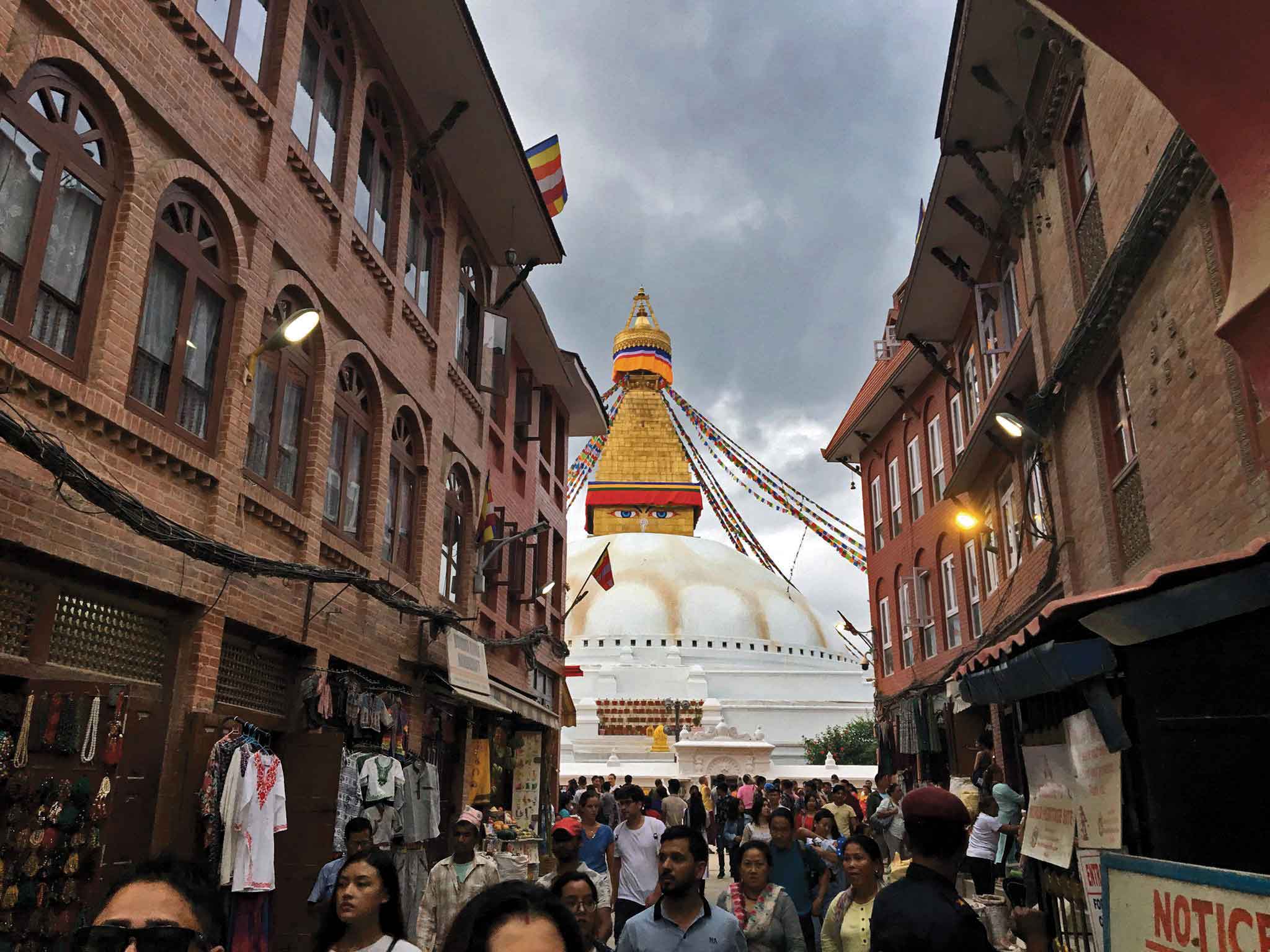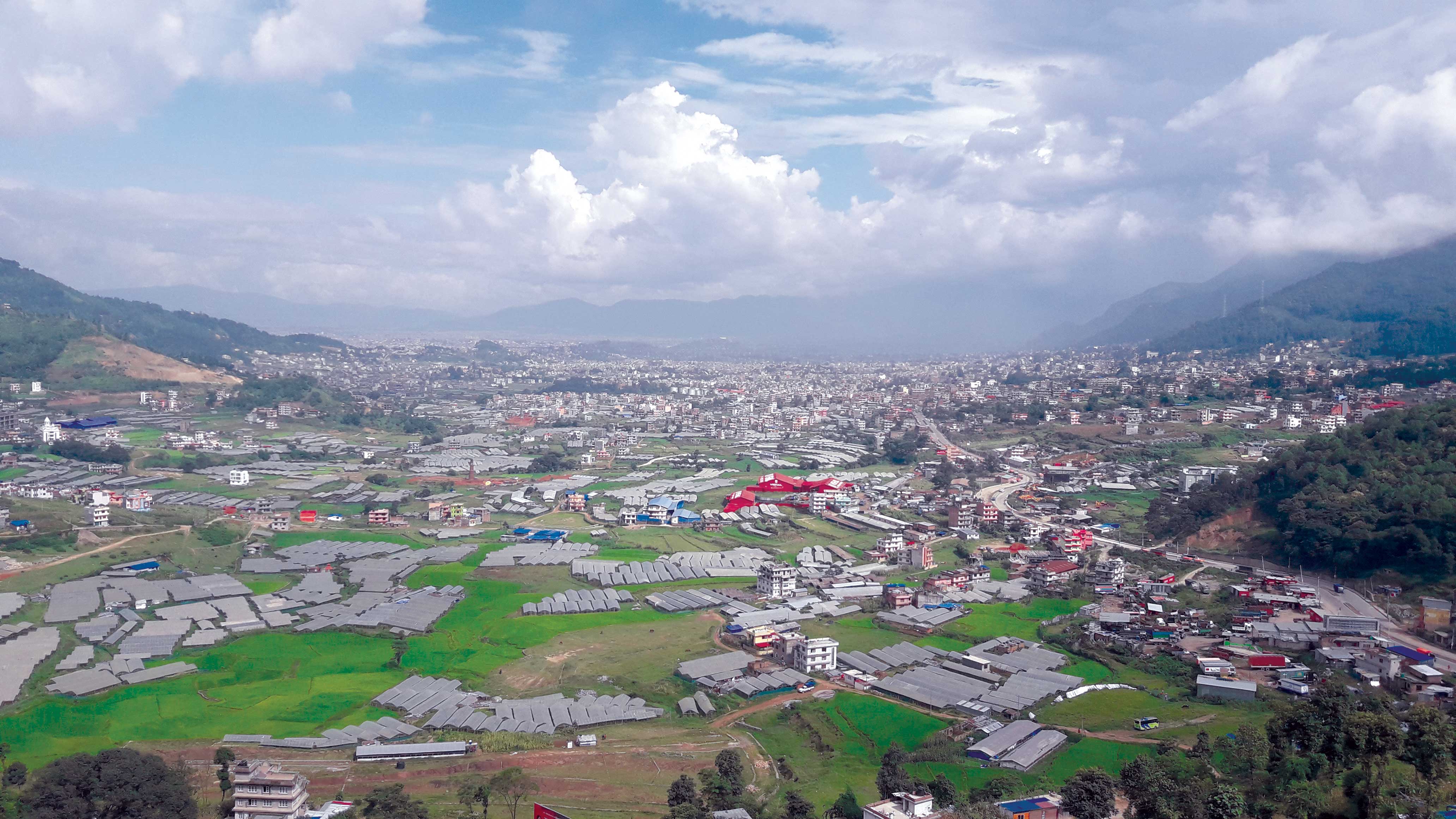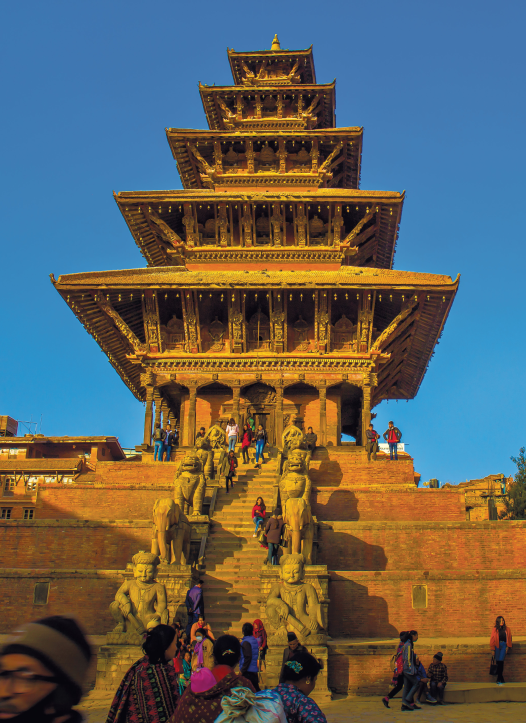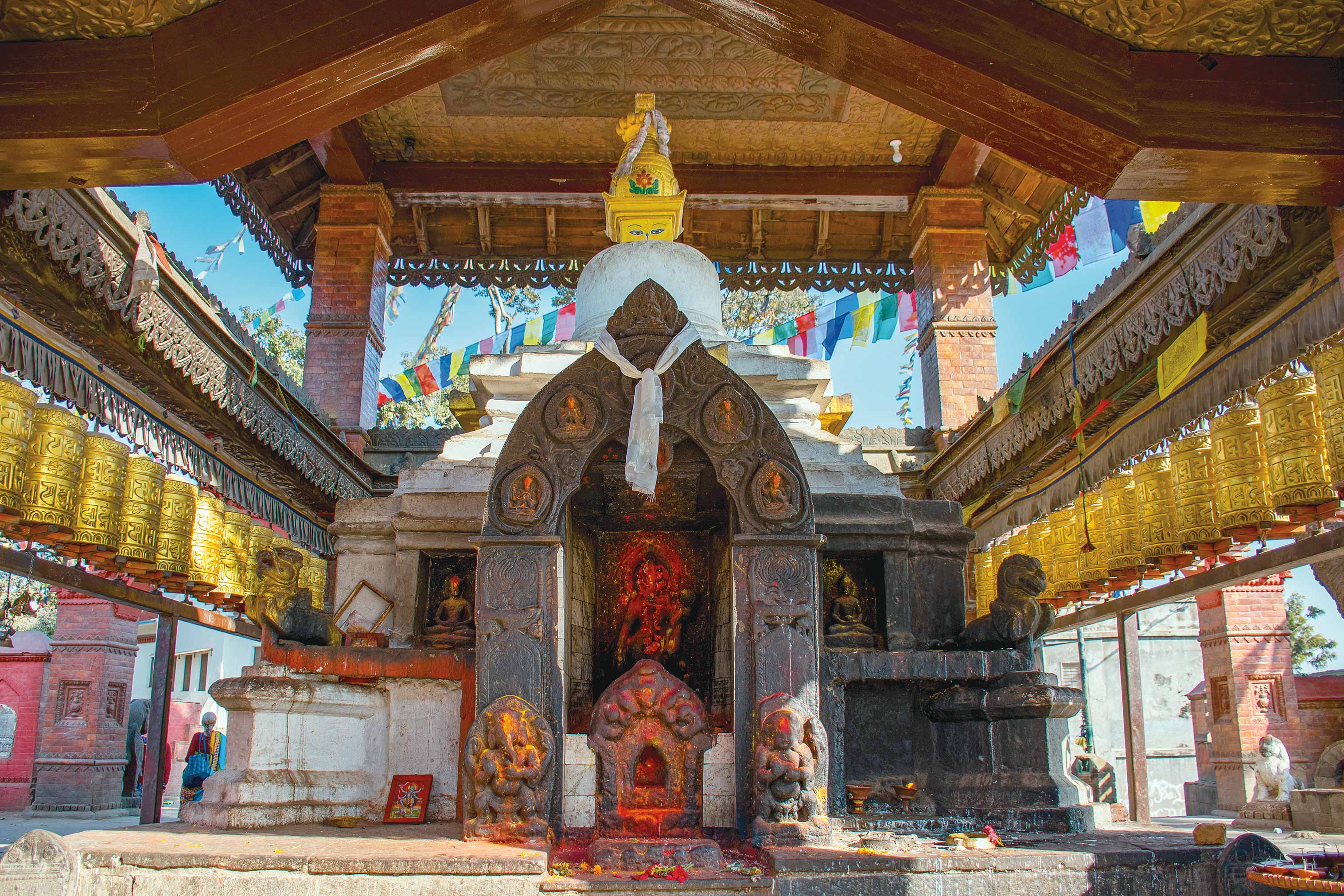Traditional style weddings, though affected by the demands of modern times, are still prevalent among Brahmins, Chhetris and some Newars and are a treat to watch and fun to be a part of.
A Traditional Hindu Wedding
By Anil Joshi
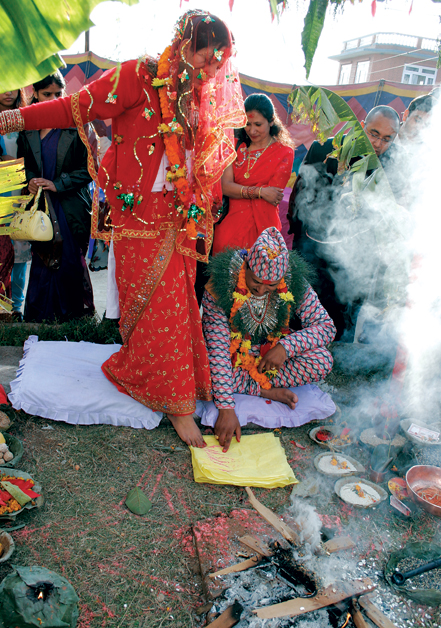 On a small street of Kathmandu members of an orchestra, dressed in red and white attire, playing brass and folk instruments work up a tune from a popular Hindi song that roughly translates as: “Will take away, will take away, the hearty will take away the bride.” Following them, tipsy youngsters dance freely and curse the cold weather. Not far behind is a latest, gleaming white Maruti decorated ornately with colorful flowers, real and those made of paper. On the doors both sides, large initials in thin red and blue paper are pasted: “P+K”. A few paces back are elders, women, girls, children and the groom’s friends in procession. Passers-by and chatting by-standers pause to look and look to pause, respectively. Above, onlookers from the houses along the street stick their heads out from the windows and terraces to get a better view. On the back seat of the car the groom, in a three piece suit and traditional Nepali cap, looks cheerful and a little anxious. A dash of a tika dots his forehead, and garlands wreathed out of seasonal flowers and dubo (an evergreen grass) is draped around his neck covering his shoulders. It is wedding time and the groom is on his way to take his bride away with him.
On a small street of Kathmandu members of an orchestra, dressed in red and white attire, playing brass and folk instruments work up a tune from a popular Hindi song that roughly translates as: “Will take away, will take away, the hearty will take away the bride.” Following them, tipsy youngsters dance freely and curse the cold weather. Not far behind is a latest, gleaming white Maruti decorated ornately with colorful flowers, real and those made of paper. On the doors both sides, large initials in thin red and blue paper are pasted: “P+K”. A few paces back are elders, women, girls, children and the groom’s friends in procession. Passers-by and chatting by-standers pause to look and look to pause, respectively. Above, onlookers from the houses along the street stick their heads out from the windows and terraces to get a better view. On the back seat of the car the groom, in a three piece suit and traditional Nepali cap, looks cheerful and a little anxious. A dash of a tika dots his forehead, and garlands wreathed out of seasonal flowers and dubo (an evergreen grass) is draped around his neck covering his shoulders. It is wedding time and the groom is on his way to take his bride away with him.
Traditional style weddings, though affected by the demands of modern times, are still prevalent among Brahmins, Chhetris and some Newars and are a treat to watch and fun to be a part of. The marriage seasons traditionally run from January to mid-March, mid-April to mid-June, and again from mid-November to mid-December.
If marriages are made in heaven, it is literally so in the Hindu system because of the belief that all major events of life are influenced by heavenly bodies; that is, by the stars, planets, moons and so on. Strict adherence to astrological and ritual aspects of the Vedas, holy scriptures dating back 5,000 years or more, stands proof to this belief system. Hindu marriage is a cumbersome process. A simple task of fixing the marriage date, for example, calls for a consultation with an astrologer who is not a family member and at times a total stranger. He decides on an auspicious date, or Subha Sahit, after gauging the influences of the celestial bodies on the bride and groom based on the dates and times of their birth. Fixing the date is but an end of a long, tedious process of setting everything on a right course. Preceding it are labyrinth of activities, like matching of kundalis and comparing and cross-checking of gotras, or ancestral lineages, of the couple. Marriages within same gotras up to five or six generations are considered unholy and unhealthy.
After matching the kundalis and zeroing in on the Subha Sahit, another custom is Kura Chhinne or engagement ceremony. Purohits or Brahmin priests of both families arrange a meeting at the bride’s place. The groom’s priest pays a visit (a mock one these days) along with his brothers, cousins and friends.
After some lyrical exchanges and deliberation, the bride’s father accepts the proposal made on groom’s behalf and offers paan and supari (betal and areca nuts) by way of invitation.
On the wedding day, the janti or procession, consisting of the groom’s family members, relatives and friends, sets out for the bride’s home. The euphoric procession, usually accomapnied by a musical band, indulges in dance and merrymaking all along the way. The procession stops a few hundred yards from the bride’s place and a group of five or six is sent with fruits and a letter informing the janti’s arrival and urging them to get ready for the welcome. This group, also called bhatkhaure, is required to inform those in charge of the preparations the number of people in the procession and to take the stock of the situation by tasting the hospitality before others. For fun sake the bhatkhaures are served tea laced with hot spices and offered a seat on the floor that either has mustard seed or throny bushes underneath covered by a thin sheet of cloth. The bhatkhaures than lead the groom and the others to the bride’s house.
The bride’s house, the marriage venue, is studded with bright twinkling lights and colorful papers cut in different shapes.
The marriage kicks off with Swayamvar, which literally means ‘Choosing the Groom by the Bride’. In the past, the bride had the right to choose one among the many suitors and not just give in to her parents’ choice as so often happens these days. Nowdays the majority of marriages, however, are a blend of love marriage and arranged marriage. After falling in love, the couple confess to their parents later, and ask them to arrange it all.
The swayamvar ceremony begins with the bride circling the groom thrice while letting the water tip down from omkhara (traditional water vessel) as she goes around. The priest applies red tika, a mixture of red vermilion, yoghurt and rice, to the forehead of the bride and the groom. Then, the bride, wearing a red sari and bedecked in jewlery, and the groom in his finery, exchange garlands and rings as the crowd from both sides bursts into cheers.
Later the bride and groom are led to a mandap or canopy for lengthy rituals that through the Vedic hymns and prayers invoke the blessings of all Hindu gods and the support of every element under the sun that will have a role in the conjugal life of the couple. The five basic elements of earth, air, fire, water and sky are highlighted time and again.
At the mandap a series of ritual are performed one after another. After a while, the priests start performing puja (worship). As per the directions, the couple take their wedding vows. The bride and groom are tied by a white cloth called lagangantho before they take rounds of the holy fire seven times. Fire is considered as a witness to holy matrimony. It purifies their union and protects them from harm in the future. By circling the holy fire seven times the couple pay due respect to the seven great sages who, in mythology, are thought to be the progenitors of human beings on earth.
Another significant ritual is Kanyadaan where the bride is formally handed over to the groom by her father. Eventually, the groom applies sindoor (vermilion) to the bride’s sinudo (the partition of hair at the top of her forehead) with a holy cloth. The grooms then ties tilhari, a necklace of beads and gold, around the bride’s neck. Under the Hindu tradition the sindoor and tilhari are the sign of a married woman.
Finally, the priests pronounce them husband and wife. Now that his wife is ardhangini, equal half, they tell him, it is the groom’s duty to protect her, to make her happy. They then bless them.
The couple is now set to leave the venue for the groom’s place. In the villages, a groom would be carried in a basket or would ride a horse and the bride would be carried on a doli or wooden palanquin carried aloft by four bearers. In the city they go by car.
At the groom’s house, Vitryaune, a welcoming ceremony for the bride, is performed. His family, usually sisters and cousins, welcome the couple doing arati where wicks soaked in camphor or oil are lighted and revolved around them. This is to keep away evil spirits and usher in good fortune. Then, Pathi-Bharne is performed by the groom’s mother; this is the filling of paddy or rice in a four kilo (one pathi) container. The bride also steps in seven piles of paddy or rice which is believed to bring positive energies inside the house.
Thus the ceremony ends in a positive note amongst celebrations. And, it is time to leave the newly weds alone.
Feast of Love: Newar Marriages
By Utsav Shakya
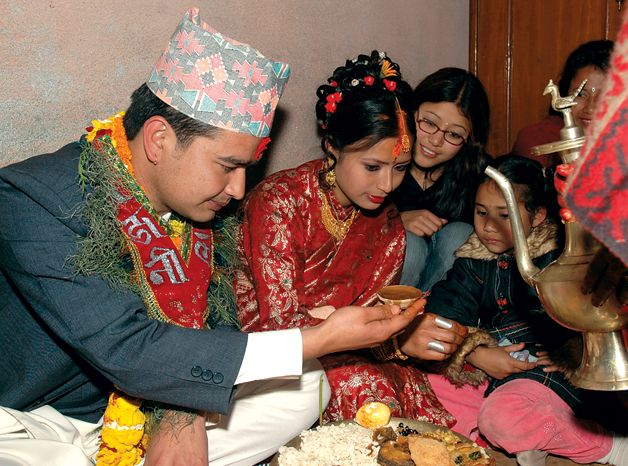
Newar marriages are highly over rated. They have been for quite some time now. Tons of money is spent on the coming together of two people, when everyone knows that money can’t buy love and certainly not the chemistry between any two people. Someone once said that people know if they are going to get along with each other in the first few minutes of the first meeting. All the signs are there, but people fail to see them and realize anything of importance. In retrospect however, all the signs glare back at people, causing immense joy for some people and inconsolable sorrow for others.
For a Newar family, marriages are also occasions to bring out the jewelry and the clothes and show off a little. There are celebrations on credit, money borrowed to invest in people. People cry, people laugh, people drink, people argue, people are weighed down by kilos of gold and, in the midst of all this, two people start a new chapter in their lives. There is no saying I do or I don’t for that matter, as the couple smile all evening and receive congratulations, gifts, flowers and envelopes with money inside that they will later sit down to count.
But anyone who knows me would slap me across my face if I acted as if all of this was not appallingly enjoyable. The food at Newar marriage parties is often times very good—prepared by local chefs who cook the same local delicacies every year. Home brewed and very hard liquor flows freely. There are traditional rites and rituals that actually make sense, besides looking and making the whole occasions feel somehow pure. And even though the sometimes-pompous nature of the whole thing might turn some people off, it actually is—and there is no other way to say this—fun. Although marriage season is now at its end for this Nepali year, allow me to guide you through what all the fuss is about.
First of all, the types of marriage we are talking about here are of the ‘arranged’ kind. There is no boy meeting girl and sparks flying. Rather there is talk initiated by the ‘lamhi’, a mediator/co-coordinator/wedding planner all rolled into one. The lamhis have very important role to play in a Newari, Brahmin and Chettri weddings, as the families of prospective bride and groom depend, entirely in most cases, on the information provided by them. A lamhi is responsible for the exchange of photos of the boy and the girl, and other details like the family’s social reputation, financial standings and so on and so forth, as in arranged marriages the social standing of the families comes first. The marriage theatrics are set off with an event called ‘Mha Swegu’, where both parties involved finally meet each other. Mha Swegu translates directly as looking at bodies but with a little less creativity, you get the idea. (!!!) Once the families approve of each other and the girl and the boy look at and approve each other’s pictures and other details, the first date finally happens.
Traditional Newar marriages usually would not even deem necessary the meeting of the girl and boy before marriage but with time, things have changed a little. There are dates, some even with a family member escort, usually on the girl’s side, tagging along. One can only imagine how freely two to be married people would talk in the company of a third wheel! On the basis of these few dates and intuition, women’s and men’s, two people decide on a lifetime commitment.
The deal is sealed by an event called ‘Gway Bigu’ or the sending of 12 pieces of supari (areca nut) in a silver bowl from the boy’s family to the girl’s. This can sometimes be accompanied by the exchange of rings, the rough equivalent of the Western engagement. The family of the groom-to-be also presents a set of clothes along with jewelry for the bride as a sort of first gift to the soon to be daughter-in-law. In most cases, this supari-taking ceremony occurs four days before the actual wedding ceremony, but it can be shifted to suit the families.
Kallya—the Newar word for ‘bangle’—is another ceremony that happens roughly around the time of the supari-taking or engagement. The event comprises of the eldest male in-law from the groom’s family presenting bangles, usually made of gold, to the bride. A clay pot called a naa-cha is also taken along for the Kallya presenting event. Besides the traditional dozen chaku laddoos, sweets made out of a rich, dark concentrate of sugarcane juice, the naa-cha can also contain items such as male as well as female dolls, balls, toys and the like. The wearing of the bangles by the bride represents the acceptance of the bride into the groom’s family. A puja ceremony takes place alongside this at the end of which the bride breaks into the paper cover of the clay pot. The bride is then made to fish inside the clay pot and without looking in come up with whatever she finds first. If the bride comes up with a male doll, then it is believed that the couple’s first child will be a boy and if she comes up with a female doll, the first child would most probably be a girl. The clay pot event is something that is introduced into the otherwise formal ceremony to infuse some humor to lighten up the mood. The engagement and the Kallya can also happen on the same day.
Four days after the Kallya, a marriage procession starts from the groom’s house with the groom in a much-decorated vehicle to formally marry the girl and bring her back home as his religiously wedded wife. Accompanied by friends and family trailing the decorated vehicle, this procession known as Janta Janey is usually led by a band of colorfully dressed musicians, with drums and trumpets, in most cases performing very loud and mostly basic covers of Hindi and Nepali film music. The procession moves along slowly around the area, a way of letting the community know that the person is getting married.
Once the groom arrives at the bride’s family home, another ceremony called a Swayambhar takes place where the bride and the groom exchange garlands made out of flowers, necklaces, rings and whatever else the involved parties wish. The end of the Swayambhar signifies the entering of the bride and groom into married life. After another rather long puja ceremony, the bride finally goes to her new home with her husband. At the groom’s home, with her lamhi by her side, the bride distributes supari to each member of her new family and family friends as the lamhi introduces her to them.
For services like these, a lamhi in older days would get not much more than a set of new clothes and food. These days however, the lamhi rakes in quite a handsome commission at the end of the day with amounts reaching up to Rs. 50,000, sometimes with gold jewelry thrown in depending upon how rich the family is.
The next day the bride and groom go to a local temple to perform yet another marriage ceremony where the groom puts red vermillion on the bride’s forehead, a symbol of matrimony not to be removed by the bride as long as they are married. In case of the death of the groom, the removal of the vermillion from the bride’s forehead signifies widowhood.
Four days later, as a way of introducing the groom to the bride’s family, the groom goes to the bride’s home and the same supari distributing event takes places, with the lamhi again by his side to introduce the members of the bride’s family to their new son-in-law. The event may also comprise of the bride’s family presenting the groom with gifts such as clothes, shoes and even jewelry. After all these ceremonies are over, there is yet another informal meeting of the families of the newly weds. This is called Samdhi Swaygu, which translated roughly as ‘Meeting of the Parents’.
The traditional Newar Jhwo-Bhwey then takes place, where people sit cross-legged on lengthy straw mats and are treated to, in my opinion, very good food. This marks the end of the Newar marriage; again, a very flashy, sometimes melodramatic ceremony full of mini-ceremonies, all of which binds two people together for a lifetime. While people might argue that some of these traditions are outdated and are a waste of time and money, my take on the subject is that people and relationships are exactly what deserve the expenditure of time and money. Everything else should come later. At a Newar marriage, this philosophy comes to life, as families give it their all for the beginning of a new chapter in their children’s lives.
Now if only life were a Newar marriage. Escorted dates, expensive clothes, great food, free flowing liquor, all for and with the person you’re spending the rest of your life with by your side. Life could not get better.
Traditional Sherpa Marriage
By Kapil Bisht
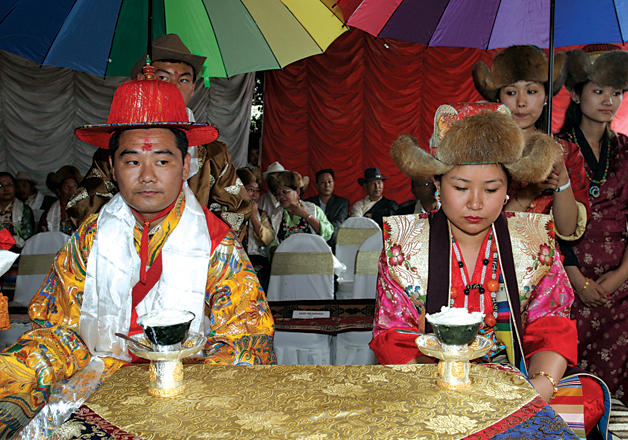
As you approach a certain age you are made cognizant of a package with a ‘made-in-heaven’ label. This contrivance is known more appropriately as marriage.
Between finding the person who is going to try together with you to run this contrivance, and the first time you try it out, is the task of assembling the efforts and events that lead up to marriage.
It is this intermediate period that we shall concern ourselves here, in the case of the Sherpas.
The Sherpas are always keen on doing things on the right day, cosmologically put, on an auspicious day.
The day selected to approach the girl’s house with a marriage proposal is decided after consulting the astrological charts of the prospective bride and groom. Their animal signs, which are conferred upon them according to their birth dates, are also matched for compatibility. The contingent that travels to the girl’s house comprises of a few of the boy’s close relatives; preferably, those whose parents are still alive, and, if they have living grandparents, so much the better. The groom’s parents however, are not part of this party to the bride’s house.
This going-over to the bride’s house to ask for her hand in marriage is known as Sodené (‘To Ask’). The ceremony is basically the presenting by the boy’s party of a jar of home-made beer, chhyang, to the girl’s parents. With the beer accepted and drunk, the girl implicitly belongs to the boy’s family.
The duration between the engagement (Sodené) and the marriage is indefinite. The boy is permitted by custom to visit the girl’s house and stay, and physical relations are initiated by the couple.
The next ceremony in the sequence of them leading up to the marriage ceremony is the Dem-Chhyang. The people who constitute the wedding procession, or janti, on the wedding day go to the girl’s house for Dem-Chhyang. The groom is not part of this procession. Though the groom’s family expresses their desire to hold Dem-Chhyang first, the date is mutually selected by the two sides. Chhyang is once again carried as a gift by the groom’s party.
Once in the girl’s house, and as a show of respect to the girl’s side, the boy’s relatives show respect by offering them chhyang and by placing khata scarves on their shoulders. With these gestures of respect completed, those present from the girl’s side respond by inviting the janti for a meal at their houses. This is known as Janti-Kyongup, meaning ‘To Entertain the Procession’. Turn-by-turn, each member of the bride’s kin must host the boy’s relatives. The duration of the Janti-Kyongup varies, depending on the number of the host families. With the procession’s need of victuals more than met, they depart. Dem-Chhyang serves to buttress the tacit ties between the couple, the foundations of which were laid during the Sodené.
Dem-Chhyang, though a decisive ceremony, does not hasten the sides towards the wedding. Time is given to the girl’s family to prepare for the wedding day. The duration is again indeterminate.
A virtuous bride—every groom’s family thinks highly of their prospective daughter-in-law—is someone one wants to usher into their household as soon as possible. ‘As soon as possible’ may possibly turn into just—‘soon’.
So we come to the next ceremony: Pey-Chhyang (from pey meaning ‘consultation’). After a considerate period (considerate because the boy’s side make their decisions keeping in mind the girl’s family, always) from Dem-Chhyang, the party on the boy’s side sets out on an auspicious day to the girl’s house with a proposed date for the wedding. This tentative date may be set at least six months hence.
The girl’s household is informed of the arrival of the boy’s party for Pey-Chhyang, and invite the people who were present for Dem-Chhyang. These invitees have a say on the selection of the wedding date, for they have once again to host the janti on the wedding day. The date proposed by the boy’s side may or may not be accepted as the girl’s side deem appropriate. If rejected, the boy’s side must come on another day, with a new date for the wedding.
If the date is accepted, this is what follows.
A week before the wedding day, in the bride’s house, the Nor Longgup is held. ‘Nor’, in Sherpa, means ‘property’; hence, Nor Longgup is the ‘Request for Dowry’ ceremony. The bride’s parents, who have kept aside their parental contribution, turn on this day to their close relatives and neighbors to make contributions to their daughter’s dowry.
Today, the gifts that are given in dowry may have come a long way from the old days when a blanket of yak-wool was the best gift one could give, which was given only by the closest of relatives. The value of the gifts given reflects the relation that binds the giver and the recipient; the closer the ties, the costlier the gift.
The Sherpas are well-versed in the art of gift-giving. The items given as gifts during Nor Longgup are selected so as to assist in the daily life of the bride. This prudence in gift-giving is reflected in the tradition of presenting the bride with large copper jars for storing water. The rationale for this gift being the lack of availability of running water.
While presenting gifts one has to declare its value. The value is then recorded and, when a girl from that person’s family is married, a gift of an equal, if not higher, value is presented.
On the day of the Nor Longgup the bride’s parents request from amongst those present the services of their daughters to be kermens. The bride’s dowry is required by custom to be transported manually and this responsibility falls to these kermens, young girls, who also befriend the bride on her way to the groom’s house.
The groom’s wedding procession includes the same people who were in the party for Dem-Chhyang, to which more may be added, including one known as Kholluwa, a layman who can perform the duties of a priest, and the other, of course, the groom. The groom is clad in a yellow brocade bakkhu (gown), a traditional cap and, preferably, high boots.
Chhyang, the pre-eminent item, is carried in wooden jars, called dozum. The groom’s party also carries femar, a conical cake made by kneading flour with butter, the size of which stands for the status of the family. The groom’s femar is later exchanged with the one prepared by the bride’s side.
The Kholluwa always leads the wedding procession, carrying a painting—the Sipa Kholu painting. The Kholluwa is thus positioned to allow him to ward off evil spirits from the path of the procession. Conchs are blown to signal the start of the journey to the bride’s house and to offer protection against negative forces. A fire lit in the courtyard signals to the bride’s relatives the advent of the groom’s wedding procession or janti. The Kholluwa performs the Serkim, a religious ritual, before the janti start off.
The wedding procession from the groom’s house to the bride’s is almost solemn; there is no singing or dancing on the way. Important articles for the return journey’s dancing are brought along, however, including several yak-tails, preferably white, and a sword.
With incense burning in the bride’s courtyard, young girls with bread, chhyang and curd await in a line to welcome the wedding procession.
Upon the janti’s arrival, the Kholluwa once again performs the Serkim, and the janti enter the bride’s house and are seated. The seating pattern is hierarchical; women usually sit on the floor, and men and women sit separately.
A light meal is served, after which the bride’s side initiate the process of introduction, known as Mola. A person from the bride’s side alludes to the janti’s attire, jewellery, physiognomy, in a light manner bordering on jest. A person from the groom’s side, chosen just for this occasion returns the compliments with bantering remarks.
After this, the groom changes into a lighter bakkhu (gown) and everyone sits down to a meal.
The meal is followed by the Janghtar, where the girl’s relatives are offered chhyang, which must be drunk from the same cup, and khatas are placed on their shoulders. This is done in a hierarchical order. The groom’s party must then sing at least three songs and dance to them. This is done for good fortune.
Then people from the bride’s side invite the janti to their homes for a meal. This hosting of the janti lasts for several days. The schedule for this hosting is so fixed that the last host family on a day is a close relative of the bride and must provide shelter for some of the janti.
On the day of the janti’s departure a ceremony called the Gyen-Kudup is held. A pair of ‘swastik’ signs (for good luck), one for the groom and the other for the bride, are made out of rice grains on a yak-wool blanket laid out flat. After the groom dons his ceremonial brocade gown once again, it is auspicious for the couple to tread on this blanket with their right foot. The groom must sit on the right, the bride to his left, both accompanied by a friend. A literate person from the bride’s side then addresses all those present, reading aloud the contents of the bride’s dowry and the values. The Kholluwa performs the Serkim, and curd is given to the bride and groom to eat. Two elders, one from the bride’s and one from the groom’s side, are selected to put butter on the groom’s and the bride’s head, respectively. They bestow blessings and advice upon the newly wedded. Thereafter, shouts of “lha-gyalo!” break out in unison, thrice, meaning ‘Victory to the Gods’, and hence, victory to everyone present.
Yak-tails flourishing, swords brandishing, conchs bellowing, with a accompaniment of bukshyal (cymbals) a few from the janti party break into the Silli Chombuk, a spirited dance that is kept up until they reach the groom’s house.
The newlyweds ask for the blessings of their parents. The bride presents gifts to her parents and siblings, then takes their leave.
A fire is lit in the bride’s courtyard to let the groom’s household know of the janti’s return. The Kholluwa leads the groom, followed by the bride, along with the kermens carrying the dowry. In the courtyard, female representatives from every family that hosted the janti are lined up, holding chhyang jars. The Kholluwa dips dhupi (incense) saplings into the jars to perform Serkim, which culminates in cries of “lya-gyalo” and the tossing of rice grains. The womenfolk lie up and, in return for their hospitality, are paid money by the janti, starting with the groom’s parents who pay the highest amount. The other members of the janti pay less, varying with their relation to the groom. With the conclusion of this ceremony, the janti proceeds to the groom’s house.
The procession is welcomed at the groom’s house by young girls and after Serkim the bride is ushered into her new home. The janti disperse after a brief session of dancing and singing. Dong-chhyang commences on the same day and continues for several days during which the groom’s relatives visit the household with gifts. This gift-giving also happens in a hierarchical order; the closest relatives visit first followed by more distant ones and by neighbors. The gifts given are recorded and, when a similar event takes places, must be reciprocated.
The kermen girls are hosted by the groom’s relatives for a few days accompanied by the bride. This acquaints the bride to her new relations. On the day of the kermens’ departure the groom’s side sends a messenger to the bride’s house with a summons. A small party consisting of the bride’s parents and close relatives arrive and a meal is served. Dancing and singing also occur. The details of the dowry are announced from a document and the bride’s father hands over this document to the eldest member of the groom’s family. This small contingent then departs together with the kermen, who bid farewell to the bride by singing songs addressed to the groom and his parents, expressing both the faith they have in them and a request to treat their friend well.
This culturally rich and fascinating manner of Sherpa marriage, of uniting two people, is unique in the collective effort of the parents, relatives and neighbors involved. It is a social occasion in its truest sense, reflecting strong communal bonds. Times have changed and so have the traditional modes of marriage just described. So, this account of how it was done traditionally, in the old days, may not necessarily be consistent with the prevalent modes of modern Sherpa marriage.
If any of you bachelors reading this decide (and if our story has anything to do with your decision) to marry, I wish you all the luck. But, since I started by stating the institution of marriage as a contrivance in a somewhat salesman-like manner (though I neither promote or put down the idea of marriage) I am obliged to say to you: caveat emptor.
Gurung Marriage
By Nandita Rana
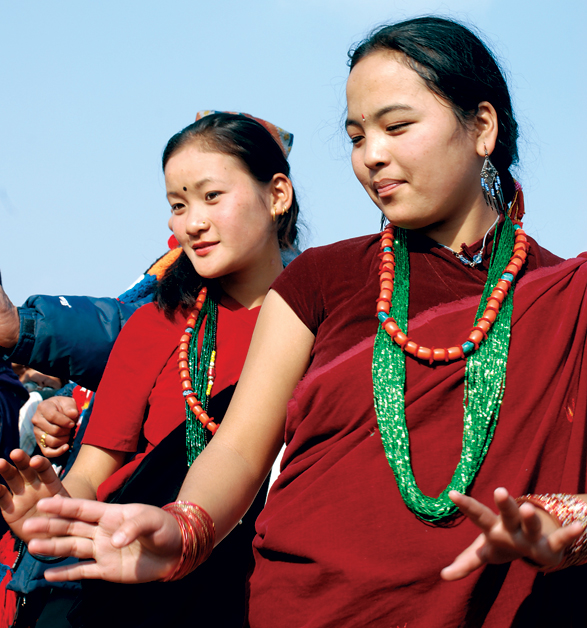
The Nepalese are serious about the institution of marriage. They regard marriage not only as a union between two people and a foundation for the continuation of a family, but a reflection of spirituality and one’s social disposition. Considering the diverse ethnicity of Nepal and the varied rituals of the ceremony among them, the Gurungs do not fail to exhibit the same ardor. For a community that places high importance on family and tradition, marriage is one of the most ritually rich and prominent celebrations.
Tamu, as the Gurungs call themselves, is one of the many ethnic groups of Nepal both in terms of their geographical distribution and their cultural makeup. The group primarily occupies the western regions of Nepal. They are particularly numerous in the districts of Gorkha, Lamjung, Kaski, Tanahu, Parbat, Syangja and Manang, all within the shadow of the Annapurna mountain range. Although located within close proximity, there are many social and cultural distinctions among the Gurungs. The Ghodane clan, for example, makes up a large proportion of Gurungs living in Parbat district. Their rituals and traditions portray considerable social distinction and generosity. In their marriage rituals, the Ghodane entertain not one but three different approaches.
The most common form of marriages among the Ghodane is Magi Biwaha, literally ‘Marriage by Proposal’, essentially an arranged marriage celebration that is typically initiated by a matchmaker upon the request of the groom’s family. First, the elders of the boy’s family approach the priest, a Lama, who examines his horoscopic chart, which he calls a chiti. He then decides on an auspicious direction and period for him to find a suitable match. The Ghodane Gurungs follow an astrological system based on what they call the Barga , which somewhat similar to Chinese astrology involving the symbolism of 12 animals to represent 12 corresponding years. The ritual of approaching the Lama for guidance is regarded to be of extreme importance for the marriage to be prosperous.
Heeding the Lama’s instruction and the matchmaker’s selection, the groom’s family prepares gifts to approach the prospective bride’s family. Gifts include food such curd in a traditional theki (wooden jug for carrying milk, curds or liquors), 100 sel roti (crispy rice doughnuts), a goat, a bowl of chicken barbeque and a bowl of chutney (pickle). These are considered to be auspicious (shagun) gifts from the groom’s side. Acceptance of the gifts by the bride’s family symbolizes consent; rejection means their disapproval. After the theki of curd is accepted by the bride’s family they organize a small get together among close family and relatives to announce their approval of the marriage.
Then, the groom’s family approaches the Lama to confirm the date of marriage as well as the compatibility of the marrying couple, corresponding to their horoscopic barga. A messenger is then sent to the bride’s family conveying the date, which usually follows within a few weeks to a month. This period gives time for the bride’s family to make final decisions and prepare for the wedding. If they happen to change their mind, for whatever reasons, then simply return theki of curd to the groom’s side, signaling the changed decision.
On the day of marriage, the groom approaches the bride in the company of a procession, a janti (the groom’s escort comprising of family members and friends), with gifts—garments , shawl, shoes, slipper, cosmetics and the like. Once at the bride’s place, they are treated with special meal and delicacies. The bride dresses up for the occasion and in some of the clothing presented by the groom.
The most important part of the ceremony takes place with the bride and groom sitting side by side. The senior members of the bride’s family then wash their feet and actually sprinkle the same water into their mouth (conducted for virgin marriages only), and later bestow them with blessings and ceremoniously giving them each tika. This ritual, called the Palikruba in Gurung, is of greatest importance in sealing the marriage. It is an emotional time for the bride’s family as it conveys the final parting of their daughter from her natal family to the groom’s family.
A wedding reception is called at the bride’s residence where all the villagers and relatives gather. A grand meal is served of traditional steamed rice, lentils, sel roti (rice doughnuts), spicy pickle, fried meat, green vegetables and raksi (local liquor). After the feast is over the bride is carried by off to the grooms house on the back of either her father or a brother.
There is one part of the ritual of departure when the bride’s sisters hide the groom’s shoes and ask for heavy compensation to have them back. The bride’s family members also try to obstruct the groom’s way as the bride is taken away, by a mock attack against them, which is fended off by the members of the janti holding umbrellas. These lighthearted events are carried out merely as a gag and for the sake of fulfilling the ritual.
Once at the groom’s place, as the bride enters the house for the first time, she gently knocks over an amkhara (a traditional copper jug) filled with rice and coins. She is more formally accepted into the groom’s home and family with a tika ceremony by the elders. This completes the formal marriage ritual. It is followed by an elaborate wedding party for the groom’s family and friends.
Presenting the newly wed couples with dowry is a common tradition for the Ghodane Gurungs. Their approach to it, however, differs from that of other ethnic and caste groups, as they consider dowry to be the bride’s aid in times of need, a sort of insurance policy in case of some sort of separation with the family. This is one reason why the dowry is given, usually after a period of one year of the marriage or after the birth of a child. The dowry in general includes items of value such as gagri (traditional copper water vessel), cutlery sets and khadgalo (a wide-mouthed copper vessel for food storage).
Another marriage ceremony of interest is the Dhurikhawa marriage, a strange yet interesting facet to the traditional Gurung marriages in Parbat District. Dhurikhawa literally means ‘pillar’ in Gurung, and is a kind of marriage where the bride is supposedly married to a pillar. This marriage is conducted in the absence of the groom at the time of marriage, especially important as many young boys from the community seek recruitment in the Nepal, Indian or British Gurkha armies and may not be home for a long period of time. It is a type of marriage in absentia, sealing the union until the groom returns to the village from abroad. A boy’s family decides upon a suitable bride for him and conducts the Dhurikhawa union at the auspicious time decided by the Lama, so as not to let it pass. The ritual acts that accompany a Dhurikhawa marriage are tentative, but essentially the same as with a Magi Biwaha, described above, with the groom’s family proposing the bride with traditional theki and shagun gifts. The only difference is that she marries the main supporting pillar of the groom’s house instead of the boy himself, while awaiting his return. At that point in the ceremony, she is given gifts and blessings from the elders and welcomed into her future home.
The third form of Gurung marriage is called Bhagauney, literally ‘running away’ or elopement. This marriage usually takes place when a couple is in love; however, one of their families disagrees for the marriage. Bhagauney is most common during Maghe Sankranti, a festival celebrated in the beginning of the holy month of Magh, around mid-January. During the festival, the groom and his family members abduct the bride and ask her to marry him. The ceremony of blessing and putting tika is concluded at the groom’s house and the bride is formally welcomed as a new family member. A wedding party is later organized for the groom’s family and friends while the bride’s family is informed of the marriage later on. The bride’s family may not agree on the wedding, but upon their approval, the bride and groom are invited to their place. There they are treated with special delicacies followed by a tika ceremony and gifts.




